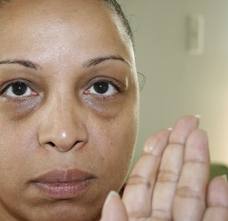It may happen nearly every single time you look in the mirror: One glance at those puffy bags or dark circles beneath your eyes sends you reaching for the frigid cucumber slices or the concealer to try and minimize their haunting and aging appearance. As women of color, this challenge has moved up the list, landing right beside dark spots and uneven skin tone.
 No one can blame you. Besides, I know how much you love getting comments about looking young and refreshed. And the last thing you want to hear folks saying is, “You look really tired. Didn’t you get enough sleep last night?”
No one can blame you. Besides, I know how much you love getting comments about looking young and refreshed. And the last thing you want to hear folks saying is, “You look really tired. Didn’t you get enough sleep last night?”
It might not be your lack of sleep – but the salty foods you eat.
While getting enough rest is definitely a factor when it comes to appearing healthy and reducing the look of tired eyes, it isn’t the only component that can be responsible for symptoms like dark circles and puffy eyes. Taking a look at the way your nutrition plays a role in these conditions helps view eye health from a more holistic approach and a “whole body” standpoint.
To that end, scientists have pegged specific eating behaviors that can make your body retain water, such as consuming too many salt-filled foods, which in turn can cause puffiness to appear around your eyes. Therefore, even though one person can suffer from swollen bags under their eyes due to allergies or irritating pollutants in the air or mold – another person’s bags could be the result of a diet high in sodium. Either way, rubbing those puffy and perhaps itchy eye bags has been pegged with making the problem worse, so try and keep your hands away from your face as you attempt to solve the problem.
So what is the best way to get rid of those problems plaguing your eyes? Overall, a good diet that’s high in leafy vegetables and healthier food choices – combined with adequate exercise and great sleep – are a few of the major lifestyle changes you can make to potentially help eliminate your under-eye bags and dark circles. Even if there isn’t a definitive, data-proven connection between adopting certain healthy behaviors and changing the skin around your eyes to something smoother and more youthful-looking, most doctors agree that your eyes truly are a big indicator of your body’s health.
What to eat, what to eliminate
If you enjoy great health overall, and aren’t aware of any underlying medical conditions causing your eye issues, your under-eye bags might really be the result of a high-sodium diet, and seeking to restore your body’s sodium balance back to normal might also help your skin coloring beneath the eyes or puffiness improve.
We’ve already discussed getting rid of too many salt-laden dishes in your daily eating plan – but did you know that reducing the amount of alcohol you consume can also help to combat puffy eyes, because liquor plays a factor in fluid retention, too?
Any sudden change, especially in under-eye puffiness, should lead you to closely examine the types of foods and drinks you’ve been consuming lately to pinpoint how your diet is affecting your eye health. Taking advantage of the latest technology to use a free app to track your food intake from day to day could be a big help in pinpointing the problem.
If you do discover you’ve been eating more sodium than usual, look for ways to cut it out, such as never adding table salt on top of food that’s already salted. Sodium is well known as a substance that causes bloating in other regions of the body – so the fact that it can make under-eye bags appear is no surprise. If that delicate balance of your body’s sodium and potassium is thrown out of whack, under-eye circles can appear.
More ways to change your diet to improve the look of your eyes
Cutting down on salty foods with lots of preservatives can be your first step to improving your diet. Replace fast foods, those convenient microwavable frozen dinners and cans of soup with fresh fruits and veggies – like bananas, kale, spinach and avocados. Go easy on things that might seem okay, like olives and pickles.
Whatever you eat, make sure to wash it down with lots of water every day to eliminate dehydration, so your body won’t have the urge to hold on to fluids that cause your eyes to puff up.
Make sure it isn’t something more serious
Hopefully by reducing your salt intake, you’ll witness your eye appearance improve. If not, try and determine if any food allergies to things like milk or wheat are the source of the puffy skin under your eyes, and that they don’t simply signify genetics at play. They could be related to gluten intolerance, which is one more condition that causes dark circles and represents a person’s allergic reaction to wheat flour. On a more severe level, the darkness could be related to celiac disease, which means you’d need a doctor to perform blood tests to verify that’s the case.
If you’ve altered your diet and don’t see improvement, consult a physician about any unrelenting under-eye bags, which can sometimes be the result kidney problems or an under active thyroid.
The role vitamins play in eye health
If you aren’t getting enough nutrients via your diet – which is oftentimes the best way to get them – seek out vitamins that can help improve your health and sleep patterns, and therefore in turn possibly improve the look of your eyes. A whole range of cosmetic issues can be blamed because of vitamin deficiencies.
A lack of vitamin K or not enough antioxidants could be the source of dark circles and puffiness, as well as a B12 deficiency being the cause of the latter in certain instances.
Therefore, examine all of the above-mentioned aspects of your eating patterns and any vitamin needs you may have in order to try and turn around the look of puffy eyes and lessen the appearance of dark circles.
As Always …
Dedicated To Your Beauty,
Juliette Samuel
Esthetician/Author/Publisher




 Facebook
Facebook Twitter
Twitter Delicious
Delicious Digg
Digg Myspace
Myspace StumbleUpon
StumbleUpon Youtube
Youtube